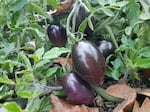Spring in the Pacific Northwest means one thing for folks with a green thumb — time to get planting. Any gardening pro will probably tell you it’s too late in the season to start growing veggies from seed, but you may need to make an exception for a new tomato variety that’s dark, mysterious, and was created right here in Oregon!
Meet the Midnight Roma: a gorgeous, dark purple tomato with a rich, concentrated flavor and a shape similar to an heirloom San Marzano.
Jim Myers is the mastermind behind the gothic tomato. As a Horticulture Professor and vegetable breeder for Oregon State University’s College of Agricultural Sciences, he developed the Midnight Roma by crossbreeding an Oregon Star and an Indigo Rose; two other varieties also developed at OSU.
Myers joined OPB’s Crystal Ligori to talk through the development of the new tomato, what gives it its purple hue, and tips and tricks for home gardeners to grow their own.
Crystal Ligori: Can you start by just telling us about the Midnight Roma? From the name, I can already guess what it looks like, but what’s so special about it?
Jim Myers: It’s Roma or paste-type tomato [with] very thick walls and not much of a seedy interior, so it’s really good for making a sauce and that sort of thing. But then what makes it different from all other types of Romas is it’s got this black skin on the outside and that’s due to the presence of anthocyanins that are in the skin. Anthocyanins are pigments that you find in many flowers [and] various fruits and vegetables. So the purple in a purple blueberry, the purple in a purple cabbage or the red in a strawberry, those are all from the anthocyanins.

Jim Myers is the mastermind behind the gothic tomato. As a Horticulture Professor and vegetable breeder for Oregon State University, he developed the Midnight Roma by crossbreeding two other varieties also developed at OSU.
Courtesy of Oregon State University / OPB
Crystal Ligori: And this tomato variety comes from two others that were also developed at OSU, right?
Jim Myers: Correct. So one parent is Indigo Rose, which I released about 10 years ago, which was the very first of what we call the indigo tomatoes that have these anthocyanins. And then the other one was a variety that my predecessor Jim Baggett bred that was called Oregon Star. And Oregon Star is where the processing characteristics come from. It’s a big, meaty, dual-purpose type, with very low seed production. Just a really nice tomato for cooking with. I wanted to make an indigo tomato that was good for processing and so that’s the parent I chose.
Crystal Ligori: Why is it important to make new plant and vegetable varieties? Is there a financial incentive for OSU?
Jim Myers: Well, breeders kind of look at what’s out there existing in terms of varieties and then what they’d like to see. Quite often it’s incorporating disease resistance or changing the plants so it’s easier to handle or to ship or to store or has better nutrition. The list of traits you can select for is pretty much endless. There is some financial incentive. We have an office of Commercial and Corporate Development [and] they generally are looking for licensing to some company that will then return some royalties back to OSU. Now, with plants, it’s generally not very much. But there is a little bit of money that comes back to my program and I plow it back into the tomato breeding program. So it’s the way to support this public breeding effort.
Crystal Ligori: The College of Agricultural Sciences has a really long history of plant breeding and developing new vegetable and fruit varieties. Can you tell us a little bit about it?
Jim Myers: The college dates back to, I think, the 1860′s if I remember correctly. It was incorporated as a land-grant university supporting learning in the Agricultural Arts and Sciences and the vegetable breeding program came about shortly after World War Two, when “Tex” Frazier came from Hawaii. He was a tomato breeder in Hawaii and he came here to breed green beans and his activities supported the green bean processing industry [in Oregon]. His successor was a graduate student of his, Jim Baggett, who was a very eclectic breeder. He bred the green beans, but he was [also] responsible for the release of maybe a dozen different tomato varieties and many other crops as well, a number of which we are still growing today.

The antioxidant-rich Midnight Roma was just released by Oregon State University. Anthocyanins in the skin give it the dark purple hue.
Courtesy of Oregon State University / OPB
Crystal Ligori: One of the parents of the new Midnight Roma is the Indigo Rose tomato, which you introduced to the market back in 2011. It was kind of the first of its kind to have that really dark purple skin. What was the reaction to that when it hit the market?
Jim Myers: Indigo Rose when it first came out was polarizing. I guess that’s the way I could describe it. People either loved it or they hated it. One of the things about these Indigo tomatoes is that you can’t use their usual visual cues for determining when they’re ripe. Normally we see a tomato turned red, we know it’s ripe, but these types mask that red color. There’s a shaded area on the fruit because the anthocyanins are light-induced, but if you look for that shaded area and you look for the color there, you can tell whether it’s still green or it’s red. And then the other thing is rather subtle, it takes some learning, but that purple color goes from a shiny, dark black purple to more of a dull brownish purple when the fruit is ripe. When the Indigo Rose first came out, we had people trying them when they were too green and then they would taste them and they say, “Oh, this is horrible, why do you release that?” (laughing) And so I’ve always tried to make sure people understand what they have to do to pick them when they’re ripe.

Row 7 Seed Company has exclusive rights to seed seeds for the Midnight Roma. Each sale supports public plant breeding research at Oregon State University.
Courtesy of Row 7 Seed Company
Crystal Ligori: For home gardeners who are interested in growing their own Midnight Roma, it’s now available to the public, right?
Jim Myers: It is, through Row 7 Seed Company. Right now, as far as I know, just seed is available [but] I would expect by next year that some of the transplanters will be growing it and selling transplants locally.
